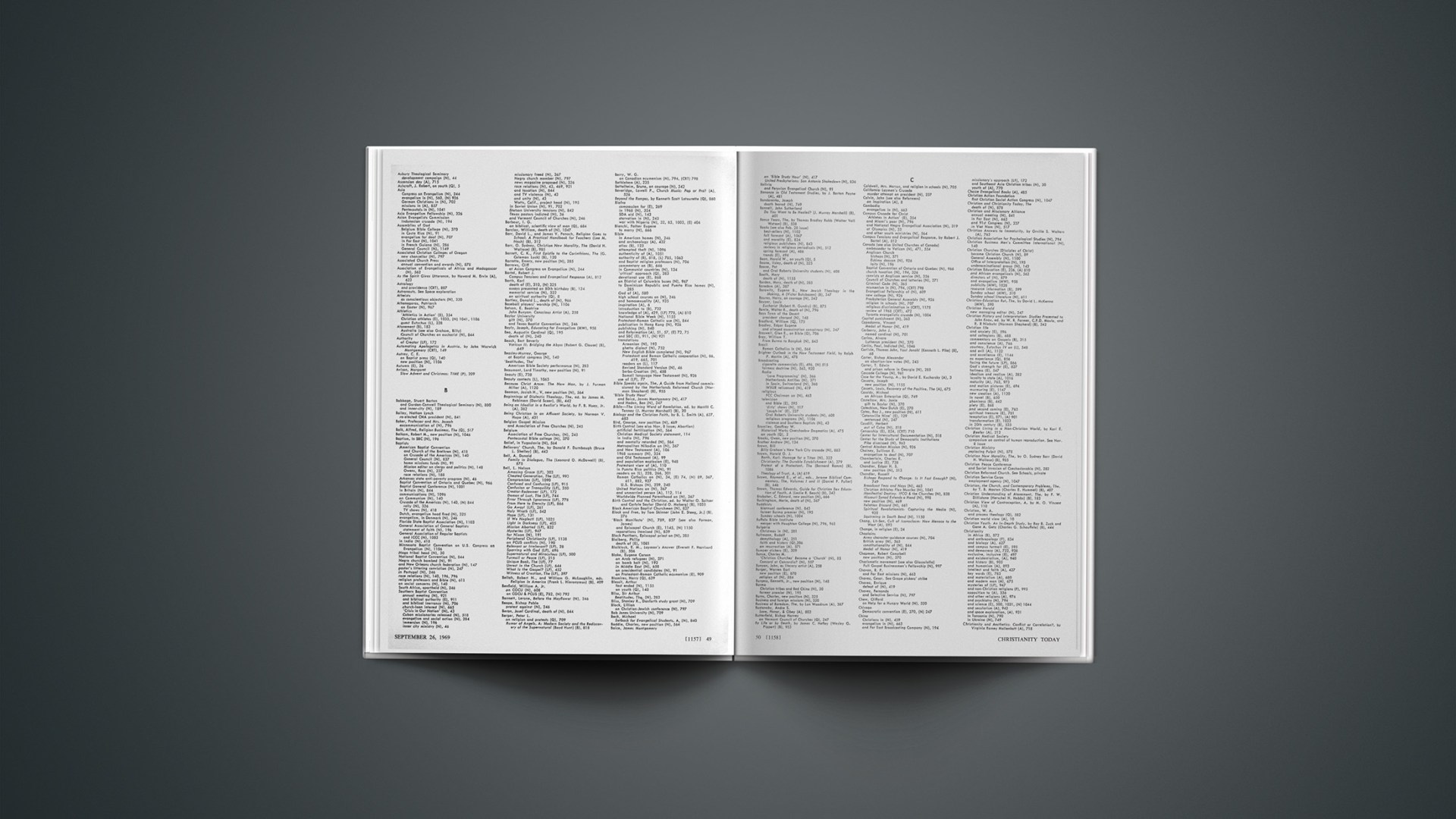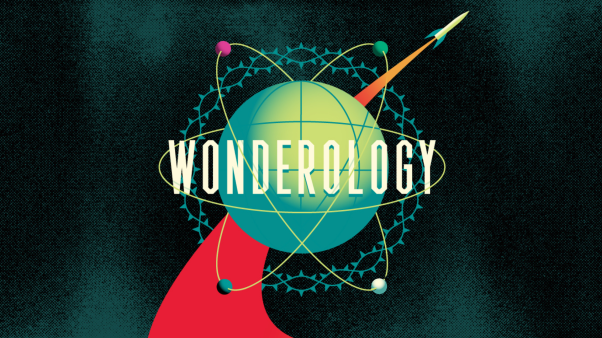Most visitors to Montreal were frantically absorbed in Expo 67’s encore: Act II of the international exhibition “Man and His World,” offering the public a bewildering kaleidoscope of human values and dysvalues. Across town at Loyola of Montreal, another international conclave was taking place, minuscule in comparative numbers but presumably of far more lofty significance, inasmuch as its official theme was “vertical”—the things of God rather than the things of man.
For the sixth consecutive year Loyola was holding its “Contemporary Theology Institute.” The subject could not have been more basic (“The Structure of Theology”) or the essayists’ lineup more promising (Lonergan, Moltmann, Ogden, Rahner, Wingren). Despite high registration fees and the disappointing last-minute non-attendance of Moltmann and Rahner because of illness (in the former case, relatively mild; in the latter, extremely severe), more than 250 selected participants arrived—hailing from as far away as France, Australia, and Japan.
Though Roman Catholics understandably predominated, Protestant attendance was considerable and the Jewish voice was represented (e.g., by Samuel Sandmel of Hebrew Union College). A high proportion of registrants were professional theologians, as evidenced by the autograph party in which participants, including the undersigned, offered their books to one another in an orgy of collective narcissism. The only significant missing element in the total picture was the Student Radical; when one buttonholed crusty Father Lonergan and offered to “make a statement and find out what the people really want,” he was told to “go conduct your own conference.”
Each of the major essayists in the five-day institute had a full day at his disposal. Gustaf Wingren, Anders Nygren’s successor as professor of systematic theology at Lund, led off; and Bernard Lonergan of the Gregorian University, Rome, followed him. It was a happy choice, since only Wingren and Lonergan not only stayed reasonably close to the subject (unlike Moltmann) but also consciously endeavored to give methodological expression to their respective confessional commitments (unlike Ogden and Rahner). (The papers of Moltmann and Rahner were read for them.)
Wingren entitled his presentations “The Structure of Protestant European Theology Today—A Critical Approach.” The accent was indeed on criticism, along the lines of his book Theology in Conflict, about which he said: “It has not yet been read seriously by anyone except those who are already supporters of Barth, Bultmann, and Nygren.” As a specialist in Irenaeus’s understanding of the recapitulation of creation in Christ and Luther’s doctrine of creative vocation, Wingren expressed particular revulsion toward the neo-orthodox theological method that absorbs the first article of the Creed (creation) into the second (redemption) and thereby splits church and world. “The modern negation of the belief in creation,” Wingren declared unqualifiedly, “has Karl Barth as its spiritual father.” But the demise of neo-orthodoxy has not provided the necessary counteractive. Now we write “large expensive books about topics without importance and slim occasional volumes about vital topics”—as if medical specialists were writing tomes on the Black Death and blood-letting, while general practitioners produced pamphlets on cancer and polio.
What is needed, stressed Wingren, is the true biblical perspective on creation, such as is offered today by Harald Riesenfeld or K. E. Lögstrup. The latter refuses to be drawn into theologies of revolution that place change-for-its-own-sake in first position but “his voice of course is not heard in the flow of words from Geneva: it does not blend with the chorus.” Logstrup has rightly hit the Kierkegaardian “hatred of everything that smacks of everyday life.” The answer, for Wingren, is a return to the biblical message of joy in the creation as redeemed by Christ’s incarnation. The Church must display “the joy she possesses. Present-day life has so little joy that one is surprised to come across it.” How is this biblical joy justified methodologically? For an anti-Barthian paper, the response was disquietingly Barthian: self-authenticating faith. Concluded Wingren: “The authority of the message does not receive any support from science.… Otherwise faith would no longer be faith.”
While Wingren spoke of recapitulating creation, Lonergan recapitulated Lonergan. His papers did little more than summarize the thesis of his major work, Insight, in which an effort is made to give our time what St. Thomas gave his: a synthesis of philosophy and theology. Lonergan builds from today’s natural and social sciences rather than from Aristotelian assumptions, and is convinced that one is thereby led to a “transcendental method,” since insight lies at the source of the patterns employed in all cognitive enterprises. How does one learn this method so as to attain the theological realm? Not from books; it is something “each one, ultimately, has to do in himself and for himself.” In self-transcendence man achieves authenticity; we “become actuality when we fall in love,” and only “being in love with God is love in an unrestricted fashion.” Insight, then, is the key to theological method. “Later revision of this notion,” stated Lonergan with somewhat unscientific confidence, “is actually not possible.… There is then a rock on which one can build.” In spite of the typical Roman Catholic synergism inherent in this position, observers were amused to discover a rock that evidently was neither Christ nor Peter!
Schubert Ogden, the University of Chicago process-theologian, delivered his papers on Bultmann’s eighty-fifth birthday, and characteristically dedicated them to him. For Ogden, who readily admitted in a question period that he was “applying Schleiermacher and the nineteenth century to new situations” and was “proud of it,” Christian theology “cannot be made intelligible by way of its own claims.” Theology proper must be approached both by way of the universal human characteristic of faith (all men consent, either authentically or inauthentically, to existence) and by philosophical theology—more specifically, Whitehead and Hartshorne’s “neo-classical theism,” in which one argues ontologically for God’s existence and (in opposition to classical theism) “ ‘God’ and the ‘world’ are correlative terms.”
Lonergan, quite readily perceiving the drift of Ogden’s method, queried: “Do you see any differences between philosophical and theological conceptions of God?” The inevitable nineteenth-century answer came back: “No.” “Unitarianism, then?” responded Lonergan. To this Ogden offered the awkward rejoinder that “the Trinity is not a specifically Christian idea.” Some participants rightly thought it curious, under these circumstances, that all men by natural religiosity were not trinitarians! Wingren astutely commented that Ogden had built his methodological house without regard to the furniture of revelation; the resulting edifice now has no apertures large enough to get the furniture in!
The absence of Moltmann and Rahner and the reading of their papers by surrogates naturally dampened meaningful discussion of their theological approaches. In the case of Moltmann, the problem was further aggravated by a non-methodological paper: a treatment of the theology of the Cross, over against Moltmann’s critics who have said that the Cross was swallowed up by the Telos in his Theology of Hope. But Moltmann’s methods were implicitly reflected in the paper: for example, in his blithe assertion that “unfortunately” Luke 23:46 has been used to interpret Jesus’ death, whereas Mark 15:34 is the true tradition and should have provided the Church’s interpretation. Moltmann’s stand-in, Father Gerald O’Collins of Australia, who knows him well, admitted that Moltmann employs the Bible very selectively; for example, much influenced by Käsemann’s rejection of the Fourth Gospel, Moltmann makes not a reference to that biblical book in The Theology of Hope.
Father Rahner’s essays, though written specifically for the institute, offered little opportunity for discussion, since they rang the changes on the inexpressible character of all true theology. Theology is transcendental, and its knowing subject is antecedent to all knowledge of particular facts (a la classical idealism); yet theology reflects the radical historicity of everything and cannot therefore set itself up as absolute (à la modern existentialism). Where does this lead? To a reductio in mysterium, wherein we discover that all mysteries reduce to the mystery of God himself. “Man must engage in self-abandonment to mystery.” Indeed, “God is mystery forever, even in the beatific vision.” At the outset of his presentations, Rahner noted that for him “linguistic philosophy is a book with seven seals.” This he effectively illustrated by making assertion after assertion whose validity could hardly be established even in principle. Linguistic philosophy has frequently noted that true believers in the ineffability of their disciplines should be really consistent and stop talking.
Although there was much talk about proper theological method at Montreal, epistemological issues had a way of being skirted. Either good theology was offered without adequate support (Wingren) or bad theology was presented as philosophically respectable (Ogden). And instead of God at center, man assumed the dominant role: man’s insight (Lonergan), man’s critical dominance over God’s revelation (Moltmann), man’s loquaciousness in the face of God’s alleged ineffability (Rahner). “Man and His World” could have been the theme here too. Many at the institute longed for an epistemologically sound analysis of a different theme: “God and His World.”










